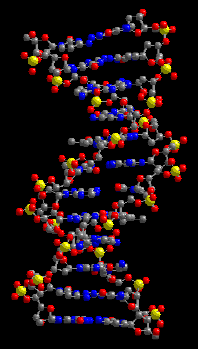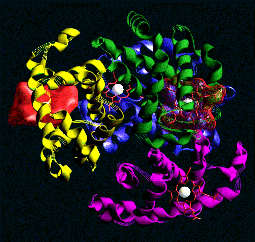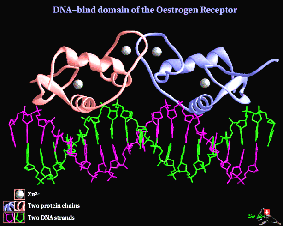In fact, even if little needs to be retracted from the conclusions Korzybski draws from the meager biological knowledge of the time (this shows the analytical power brought by general semantics), one must acknowledge that some passages in Chapter IX have become quite debatable, indeed frankly "false to fact." Moreover, while expounding on colloids, Korzybski seems to have missed some of the fields of knowledge then emerging, such as enzymology, which have gained great importance in modern molecular biology (1997).
Debatable Premises...
Today it is considered that the colloidal state can be characterised by a criterion of size, d (1 Å = 10-10m):
| Suspension | |
| Colloidal State | |
| Micromolecular Solution |
This criterion is not, however, perfectly satisfactory, for the particles do not all extend equally in each dimension. Alongside more or less spherical particles such as globular proteins, there can exist highly elongated particles such as DNA molecules. At present (1997), the criterion for classification among the three states of dispersion is instead the number of atoms n each particle contains:
| Suspension | |
| Colloidal States | |
| Micromolecular Solution |
When Korzybski asserted, "The smallest particle visible in the microscope is still about one thousand times larger than the largest molecule" (p. 111), he did not anticipate the discovery of DNA, because the chromosome of Escherichia coli (in biology laboratories Escherichia coli is, among others, a bacterium subjected to every imaginable and even some unimaginable cruelties), as a linearised molecule, measures about 4,639,221 base pairs x 3.4 Å / base pair, that is to say 1.58 mm long.
A little further along, talking about nervous fibers, Korzybski writes: "In protoplasmic structures, such as a nerve fibre, the internal protoplasm and surrounding medium are the two phases, separated by a surface film of modified plasm membrane. In both systems, the electromotive characteristics of the surfaces are determined by the character of the film." (p. 114) This is partly false, because the cell dynamically maintains gradients in the concentration of salts between the interior (high in potassium K+ and low in sodium Na+) and the exterior of the fiber (low in potassium K+ and high in sodium Na+). This process consumes energy and is under the control of a "sodium pump" and a Na+/K+-dependent ATPase.
One cannot help laughing when Korzybski asserts that: "Experiments show that there are four main factors which are able to disturb the colloidal equilibrium... (1) Physical, as, for instance, X-rays, radium, light, ultra-violet rays, cathode rays. ; (2) Mechanical, such as friction, puncture. ; (3) Chemical, such as tar, paraffin, arsenic. ; and, finally, (4) Biological, such as microbes, parasites, spermatozoa, . In man another (fifth) potent factor; namely the semantic reactions, enters, but about this factor, I shall speak later." (p. 116) It is clear that today we would speak instead of a mutagenic effect on the DNA, for the "physical" factors, without considering it a question of a "disturbance" of the DNA colloid. The only type of disturbance that a puncture can create in a man is, for instance, that which transmits HIV, if the needle used is infected. Much the same, in smokers, the tar works more by inducing mutagenic effects on their bronchial DNA than by disturbing their "colloidal equilibrium". Each pathogenic microorganism presents a specific physiopathology. For example, HIV, by destroying the subject's lymphocytes, will render him particularly sensitive to secondary infections that are benign for subjects with intact immune systems (so-called "opportunistic" infections).
A little later, Korzybski explains to us that: "The action of all drugs is based on their effect upon the colloidal equilibrium, without which action a drug would not be effective." (p. 116) This assertion is so vague and general that it contains practically no information and borders on the ridiculous if transcribed into current language: "A substance must interact with an organism to have an action, for if it did not do so it would not have an effect."
The following assertion is totally "false to fact", to borrow one of Korzybski's usual expressions: "Thus, ether of equal concentration will make a man unconscious, will prevent the movement of a fish, and the wriggling of a worm, or stop the activity of a plant cell, without permanently injuring the cells." (p. 116) Quite evidently, today we know that what matters is the quantity of product used per unit weight of organism treated and per unit time, and not the concentration of product, a man of 70 kg being considered a "standard" individual.
Another "false to fact" statement encountered a bit later: "Different regions of the organism have different charges; but, in the main, an injured, or excited, or cooler part is electro-negative (which is connected with acid formation), and the electro-positive particles rush to those parts and supply the material for whatever physiological need there may be". (pp. 116-117) To paraphrase a famous television series: "The Truth is Out There"!
The X-rays were also given a colloidal spin, with as little success:
"The X-, or Röntgen-rays have
been shown to accelerate 150 times the process of mutation. Muller, in his
experiment with several thousand cultures of the fruit fly, has established
the above ratio of induced mutations, which become hereditary.
'Cosmic rays' in the form of radiation from the earth, in tunnels,
for instance, show similar results, except that mutation occurs
only twice as often as under the usual laboratory conditions." (p.117)
Scientists now know of X and ![]() radiations that the intensity of mutagenic
effects on DNA is directly proportional to the dose received (without
any repair system). The Chernobyl disaster (April 26, 1986) showed
that a significant dose could kill a man in hours.
radiations that the intensity of mutagenic
effects on DNA is directly proportional to the dose received (without
any repair system). The Chernobyl disaster (April 26, 1986) showed
that a significant dose could kill a man in hours.
Yet further along Korzybski wrote "What are usually called 'vitamins' do not only represent 'special substances', but become structurally active factors; and this is why ultra-violet rays may produce results like those of some 'substance'." (p. 118) This conclusion is quite evidently "false to fact" and shows us the point at which one must beware of "obvious" inferences; UV does nothing but activate at the level of the skin the chemical transformation of 7-dehydrocholesterol (an inactive precursor) into cholecalciferol or Vitamin D3 (a natural form of "Vitamin D"). In no case does UV have a "Vitamin D-like" action.
Four lines later and still on the topic of vitamins, Korzybski writes: "Some data seem to show that, in some instances, surface-active materials, such as coffee or alcohol, produce beneficial surface activities similar to the 'vitamins'." (p. 118) In our day (1997), coffee and especially alcohol are no longer considered "politically correct" in the USA; nevertheless, tobacco produces, while burning, an excitatory substance, nicotine, that is very near to a vitamin, the amide of nicotinic acid (vitamin PP). In spite of this, it seems that of the three stimulants mentioned tobacco is the substance least "politically correct" in the USA (harassment of smokers).
Further still, Korzybski approaches the study of epilepsy in a curious way: "Thus, if the serum from an epileptic patient is injected into a guinea pig, it results in an attack of convulsions, often ending in death." (p. 118)
This is called "analphylactic shock" and bears no relation to epilepsy. The serum of a healthy subject, injected into a guinea pig, causes similar deadly symptoms. Taking that into consideration, one would suspect the immune system and antibodies: ESGS investigates.
Korzybski also explains tuberculosis: "This would explain also why, in some instances, psychotherapy is effective in diseases with tubercular symptoms." (p. 119) I would recommend that readers in such a situation seek a standard treatment with rifampycine instead of psychoanalysis.
While he placed considerable importance on colloids, Korzybski was completely unaware, in 1933, of whole areas of biology that would appear so important thereafter. We will mention but two fields that have become vitally important today:
Correct conclusions...
From all of this data, some of it "false to fact", Korzybski generalises and draws astonishingly correct conclusions: "When we analyse the known empirical facts from a structural point of view, we find not only the equivalence which was mentioned before, but we must, also, legitimately consider the so-called 'mental', 'emotional', and other semantic and nervous occurrences in connection with manifestations of energy which have a powerful influence on the colloidal behaviour, and so ultimately on the behaviour of our organisms as-a-whole. Under such environmental conditions, we must take into account all energies which have been discovered, semantic reactions not excluded, as all such energies have structural effect. As language is one of the expression of one of those energies, we ought to find it quite natural that the structure of language finds its reflection in the structure of the environmental conditions which are dependent on it." (p. 121) Upon reading this paragraph it becomes clear that Korzybski manages to keep from getting tossed out of the ballgame by knowing what would qualify as a good conclusion before he drew it, because "the only possible content of knowledge is structural."
Bringing our knowledge up to date...
In spite of this it is useful to bring our own knowledge up to date, because only by bringing our knowledge closer to the processes studied can we hope to interact successfully with them.
Certain biological discoveries have marked the twentieth century, particularly the discovery of DNA and its role in the transmission of genetic information from one generation to another (Avery, McLeod, and McCarty, 1944). One can imagine DNA as a magnetic tape containing all the information necessary for the construction and functioning of a given living being. RNA is copied from the DNA, as messenger RNA. Within the cell, messenger RNA (mRNA) conveys DNA information to the ribosomes, where it is translated into proteins. In this process, ribosomes are acting as actual factories, specialised in protein synthesis. The structure of DNA was elucidated by Crick and Watson (1953); it has a two-stranded helical structure, each strand comprising a great many nucleotides, be they purines (guanosine monophosphate [GMP] and adenosine monophosphate [AMP]) or pyrimidines (cytosine monophosphate [CMP] and thymidine monophosphate [TMP]). It is possible to represent symbolically (a very high order of abstraction!) a DNA strand as a sequence of the four characters A, C, G, and T. For example, here is the highly symbolic representation of a simple DNA strand as it might appear in databases:

GCGCGCCGTG CGCCCGAGCG ATACTGAGCG AAGCAAGTGC GTCGAGCAGT GCCCGCTTGT 60
TCCTGAAATG CCAGTAAAGC GCTGGCTGCT GAACCCCCAG CCGGAACTGA CCCCACAAGG 120
CCCTAGCGTT TGCAATGCAC CAGGTCATCA TTGACCCAGG CGTGTTCCAC CAGGCCGCTG 180
(Fig. 1: DNA twelve base pairs in length)
The discovery of the genetic code and of the primary, secondary, and
tertiary structure of proteins heralded the dawning of molecular
biology in the 1960s. Proteins, which may be enzymes or may play a
structural role in the cell, comprise linear chains of L isomers of
amino acids. In the primary structure of proteins, the amino acids
(A), which are amphoteric molecules (acidic and basic at the same
time), are joined by peptide bonds (here CO-NH):

(Fig. 2: 3D representation of hemoglobin)
NH2-AA1-CO-NH-AA2- ...
-AAn-1-CO-NH-AAn-COOH
It is thus possible to distinguish in a protein an N-terminus (NH2-) and a C-terminus (-COOH). Twenty different amino acids are found in proteins: alanine (Ala, A), arginine (Arg, R), asparagine (Asn, N), aspartic acid (Asp, D), cysteine (Cys, C), glutamine (Gln, Q), glutamic acid (Glu, E), glycine (Gly, G), histidine (His, H), isoleucine (Ile, I), leucine (Leu, L), lysine (Lys, K), methionine (Met, M), phenylalanine (Phe, F), proline (Pro, P), serine (Ser, S), threonine (Thr, T), tryptophan (Try, W), tyrosine (Tyr, Y), and valine (Val, V). Thus it is possible to render a highly symbolic representation of a protein by groups of three letters as follows:
MetAlaArgSerGlyValLeuTyrLeuHisValAlaGlnAlaAlaThrGlnLeu
ValAlaAlaGlyHisAsnProThrIleAspSerIleArgValAlaLeuGlyGly
...
GluSerGlnLeuSerGlnLeuAlaThrGluLysGlnLeuLeuValGlnAspAsn
AlaValLeuSerSerGlnLeuAlaGluSerArgAlaMetLysProLysThrCys

(Fig. 3: Estrogen receptor bound to the double helix of a DNA molecule.)
If one uses the single-letter code, the symbolic representation of the same protein is far more compact. Databases of course employ this form:
MARSGVLYLHVAQAATQLVAAGHNPTIDSIRVALGG
...
ESQLSQLATEKQLLVQDNAVLSSQLAESRAMKPKTC
For those who wish to keep their knowledge of biology up to date, I highly recommend regular visits to the Massachusetts Institute of Technology (MIT); the webserver of MIT's Experimental Study Group (ESG) is especially remarkable.